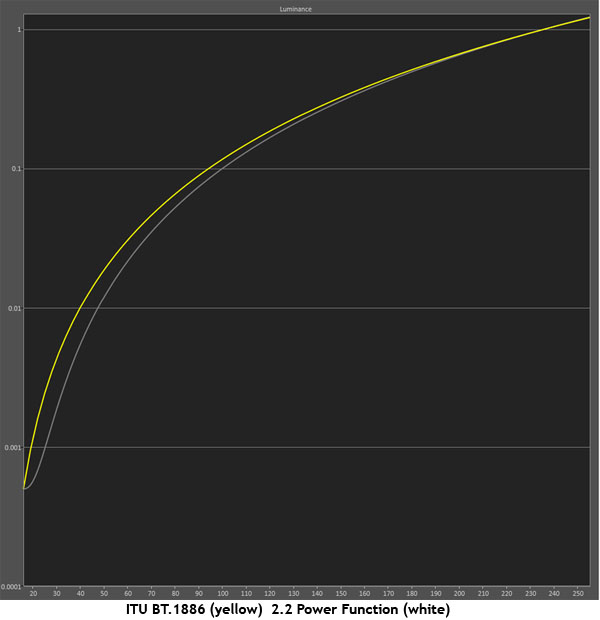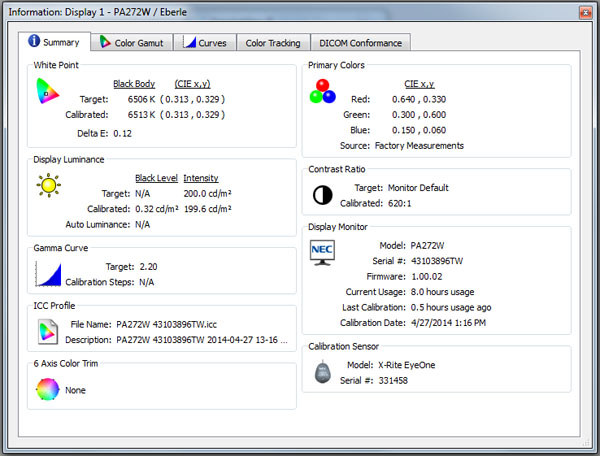NEC PA272W 27-Inch Monitor Review: Accuracy And Flexibility
We’ve reviewed a lot of professional-class monitors, NEC's PA272W may be the most accurate and capable one ever to hit the Tom's Hardware lab. At almost $1300, it’s expensive for a 27-inch QHD screen. But there are features here you won’t find elsewhere.
Calibration With SpectraView
For our benchmark tests, we calibrated the PA272W solely through its OSD, though the monitor can also be adjusted via NEC’s SpectraView software. It sells separately for $99, or $299 with an i1Display Pro colorimeter. A license key was included with our press pack, so we downloaded the latest version to give it a try.
Setup could not be easier. After installing the application, connect a supported meter to your computer (we used our i1 Pro) and start it up. Other compatible meters include X-Rite’s ColorMunki and Datacolor’s Spyder 2, 3, and 4 models. If you want to connect the meter directly to the PA272W, you'll have to run a USB cable between it and the computer.
This is the main screen. You can use one of the preset targets or create your own. All of the parameters are listed so you know what the targets are. SpectraView also tells you the last calibration date and when it’s due next. NEC recommends re-calibrating every two weeks. If you have multiple displays, you can select and configure them separately.
All calibration parameters can be edited to your preference. Our sample screen is set for a D65 white point with 200 cd/m2 max intensity, a 2.2 gamma curve, and an sRGB color gamut. You’ll notice in the gamma choices there is a new standard, BT.1886, which has been recently adopted by the television and film industry. Here’s a graphic that compares the two curves.
BT.1886 bumps up light output at the lower brightness levels and flattens it out until around the 80-percent mark, where the two curves become identical. The end result is better shadow detail and a little more pop in the mid-tones.
Now that content providers are migrating to this new gamma standard, displays will have to include the BT.1886 gamma option in their calibration toolkit. The PA272W is the first computer monitor we’ve seen that supports it, though you’ll have to use SpectraView to access the preset. It isn’t in the OSD.
To select a color gamut, you can choose a preset from the drop-down list or enter the CIE coordinates manually. The yellow triangle shows the PA272W’s native gamut, which matches Adobe RGB 1998. Any gamut inside can be specified.
Get Tom's Hardware's best news and in-depth reviews, straight to your inbox.
To create a custom white point, enter a color temperature value in Kelvins or type in the CIE xy values. If you’d rather use a visual comparison, operate the intensity slider and RGB controls to set the white point, then measure it for inclusion in your custom calibration.
Once you’ve set your options, click Calibrate on the main screen and follow the meter placement instructions. Our rig took about 10 minutes to do its thing. Depending on how much adjustment is required, it could take longer.
When it’s finished, the results are summarized in the above window. You can store multiple calibrations on your PC and recall them at any time. The values are written to the PA272W’s internal LUT, so no drivers or running apps are required. You’ll notice that a picture mode called SpectraView is added to the OSD. Because it doesn't replace any of the others, you can still access the monitor's previously-discussed presets. And an ICC profile is automatically generated and installed, so you can go right to your graphics apps and access the new calibration.
We’ve seen applications like this from Samsung and Dell, but NEC’s SpectraView is the easiest and fastest one yet. Our only beef is that it’s not included with the monitor. Many users already own the necessary meter; all they would need is the application.
Current page: Calibration With SpectraView
Prev Page OSD Setup And Calibration Of The NEC PA272W Next Page Measurement And Calibration Methodology: How We Test
Christian Eberle is a Contributing Editor for Tom's Hardware US. He's a veteran reviewer of A/V equipment, specializing in monitors. Christian began his obsession with tech when he built his first PC in 1991, a 286 running DOS 3.0 at a blazing 12MHz. In 2006, he undertook training from the Imaging Science Foundation in video calibration and testing and thus started a passion for precise imaging that persists to this day. He is also a professional musician with a degree from the New England Conservatory as a classical bassoonist which he used to good effect as a performer with the West Point Army Band from 1987 to 2013. He enjoys watching movies and listening to high-end audio in his custom-built home theater and can be seen riding trails near his home on a race-ready ICE VTX recumbent trike. Christian enjoys the endless summer in Florida where he lives with his wife and Chihuahua and plays with orchestras around the state.
-
SuckRaven Every time Tom's Hardware reviews monitors, I keep posting in the comments that they should review NEC and EIZO for accuracy in comparison to the usual suspects. Finally my prayers have been answered. (Not that there are not other places that have not already done a good job of including reviews of high-end monitors with color accuracy, and uniformity as the main focus), but Tom's has always been a preferred resource. Anyways, you guys should do a shootout with the top flagships from HP, Dell, NEC and and EIZO, perhaps the CG277). Nice review.Reply -
Pikker I've recently purchased this monitor with calibration tools and hood for a discounted price, needless to say it looks incredible, putting to shame an older 27" IPS display that I had.Reply
Regarding the NEC 272 vs. Eizo 277, I think they are more same than different... the Eizo has an integrated calibrator, 16-bit LUT, bigger color space, and a bunch of other tweaks that should objectively make it a better display, but not ~$1000 better IMO. If you have that kinda money to burn, get two PA272W's instead. -
ubercake Good review.Reply
I think everyone should notice the low-cost IPS monitors offer sub-par contrast. Who cares about color accuracy if you can't see the in-betweens? Aren't the shades/hues just as important? This is something people don't realize when they pick up that $400 IPS display. Heck, contrast is better on the BenQ TN display than on the less expensive IPS displays in the review. Color without good contrast is a waste. Contrast is what you compromise at the lower end of the IPS monitor scale.
You have to spend money to get a quality IPS monitor. It's good to see that you can get this kind of performance at a lower price point now.
This NEC monitor is definitely impressive. It has great color accuracy AND contrast. Great for photography and graphic arts/design applications. This is a pro monitor and why you spend money on an IPS monitor. -
ceberle Reply13488868 said:Every time Tom's Hardware reviews monitors, I keep posting in the comments that they should review NEC and EIZO for accuracy in comparison to the usual suspects. Finally my prayers have been answered. (Not that there are not other places that have not already done a good job of including reviews of high-end monitors with color accuracy, and uniformity as the main focus), but Tom's has always been a preferred resource. Anyways, you guys should do a shootout with the top flagships from HP, Dell, NEC and and EIZO, perhaps the CG277). Nice review.
Look for a review of the HP Z27x in a few weeks. It's in our lab now.
-Christian- -
PapaCrazy Bought one of these and ended up with a display that had several dead pixels and a couple hot pixels. Exchanged it, got a display with even more deal pixels, I stopped counting in the teens. For $1400, seems offensive. Dell was offering a zero dead pixel guarantee for half the price with the u2711. Calibrated, it seems to do quite well in color accuracy, I never get complaints after file deliveries, but the Dell is made like a piece of shit. Has a major heating problem which effects the top (where the heat collects) of the display's color output after intensive usage. I'm sick of this over-inflated display market. They are either under-engineered or overpriced.Reply -
Pikker ReplyBought one of these and ended up with a display that had several dead pixels and a couple hot pixels. Exchanged it, got a display with even more deal pixels, I stopped counting in the teens. For $1400, seems offensive.
That's some bad luck... I got mine from B&H and the display was perfect out of the box. Otherwise, the thing is built like a tank with an all-metal frame under the plastic outer shell, and it doesn't flex no matter what, if anything, I'd say it's over-engineered. -
PapaCrazy Reply13514585 said:Bought one of these and ended up with a display that had several dead pixels and a couple hot pixels. Exchanged it, got a display with even more deal pixels, I stopped counting in the teens. For $1400, seems offensive.
That's some bad luck... I got mine from B&H and the display was perfect out of the box. Otherwise, the thing is built like a tank with an all-metal frame under the plastic outer shell, and it doesn't flex no matter what, if anything, I'd say it's over-engineered.
Got mine from B&H too. NEC released an upgraded model w/ improved colorimeter shortly after my purchase. It could very well have been an accumulation of old stock, the backwash of sorts, that I drank from. When studying up, I found the only way to get a guarantee of zero dead pixels on NEC displays, you need to pony up for the ultra-expensive medical grade displays. It is well made though, I thought the portrait mode was a great feature and the stand was far more solid than the Dell's. Ran cooler as well. (thermally I mean)





